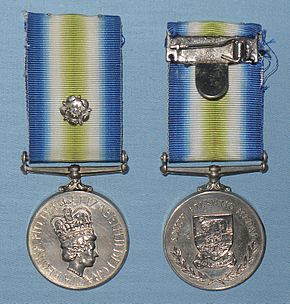South Atlantic Medal facts for kids
Quick facts for kids South Atlantic Medal |
|
|---|---|

Obverse, with rosette, and reverse of medal
|
|
| Type | Campaign medal |
| Eligibility | British Armed Forces, Merchant Navy and civilians |
| Awarded for | Service in the South Atlantic, during the Falklands War |
| Campaign(s) | Falklands War |
| Description | Cupronickel disk, 36mm diameter. |
| Clasps | No clasp, but a rosette. |
ribbon bars of the medal |
|
The South Atlantic Medal is a special award given by the United Kingdom. It's a campaign medal for British soldiers, sailors, air force members, and even some civilians. They received it for their service during the Falklands War in 1982. This war was fought between the United Kingdom and Argentina. More than 33,000 of these medals have been given out. In 1997, an organization called the South Atlantic Medal Association was created for people who received this medal.
Contents
What the Medal Looks Like
The South Atlantic Medal is made from a metal called cupronickel. It is about 36 millimeters wide. The Royal Mint made these medals. The Army Medal Office then gave them out.
Front of the Medal
The front of the medal shows a picture of Queen Elizabeth II. She is wearing a crown and looking to the right. Around her picture, it says: "ELIZABETH II DEI GRATIA REGINA FID:DEF". This Latin phrase means "Elizabeth II, by the grace of God, Queen and Defender of the Faith".
Back of the Medal
The back of the medal has the Falkland Islands' coat of arms. This coat of arms includes the words "DESIRE THE RIGHT". This phrase is a nod to an old ship called the "Desire" which belonged to the English explorer John Davis. Below the coat of arms is a laurel wreath. Above it, the words "SOUTH ATLANTIC MEDAL" are written around the edge.
Medal Details and Ribbon
Each medal has the recipient's name, rank, service number, and unit carved into its edge. However, Royal Navy officers did not have their service number on the medal.
The medal hangs from a 32-millimeter wide ribbon. This ribbon has a green stripe in the middle. On each side of the green stripe are white and blue stripes. These colors and wavy patterns are meant to look like the Atlantic Ocean. Queen Elizabeth II herself designed this ribbon. It was inspired by the ribbon for the Atlantic Star, a medal from World War II.
Who Received the Medal
The South Atlantic Medal was given out based on where and when people served.
Medal with a Rosette
Some medals have a small rose-shaped decoration called a rosette on the ribbon. This medal was given to people who served for at least one day in the combat zone. This zone was between 35° and 60° South latitude. Or, they had to complete at least one mission south of Ascension Island. This period was from April 2 to June 14, 1982. April 2 was when Argentina invaded the Falkland Islands. June 14 was when the fighting stopped. The rosette was worn both on the medal ribbon and on the smaller ribbon bar.
Medal Without a Rosette
The medal without a rosette was given for 30 days of service. This service could be continuous or spread out. It had to be between 7° and 60° South latitude. The service had to happen between April 2 and June 14, 1982, and finish by July 12, 1982.
Later, in 2014, the time period for getting the medal without a rosette was extended. It now included service up to October 21, 1982. This was because people on the islands after June 14 were still at risk. Also, the RAF Stanley airfield needed work to allow RAF Phantom jets to operate.
The rosette is quite unusual for a British medal. It was used to make medals faster and save money. Also, without it, very few medals would have gone to the Royal Air Force. Most Royal Air Force members who got the medal did not get a rosette. This is because they were often based on Ascension Island. This island is about 3,300 kilometers north of the Falkland Islands, far from the main war zone. An exception was the Royal Air Force Regiment, who had a squadron land in San Carlos on June 1.
People who were mentioned in official reports for their bravery during the war wear a bronze oak leaf on their medal ribbon.
Service that counts for the South Atlantic Medal does not count towards another medal called the Accumulated Campaign Service Medal.
Medal Recipients by Branch
About 29,700 people first received the medal. This included Prince Andrew. Members of the Merchant Navy and civilians could also get the medal. For example, government workers on Ascension Island, NAAFI staff, artists like Linda Kitson, and journalists with the armed forces, such as Michael Nicholson, received it.
By November 3, 2017, an extra 3,626 medals without a rosette had been given out. This was because the qualifying period was extended to October 21, 1982.
Here's a breakdown of how many medals were given to each group:
| Branch | Medals issued |
|---|---|
| British Army | 6,968 |
| Royal Air Force | 2,008 |
| Royal Navy | 12,927 |
| Royal Marines | 3,729 |
| Royal Fleet Auxiliary | 1,960 |
| Merchant Navy/Civilians | 2,090 |
| Further awards from 2014, on extension of qualifying period to 21 Oct 1982 |
3,626 |

